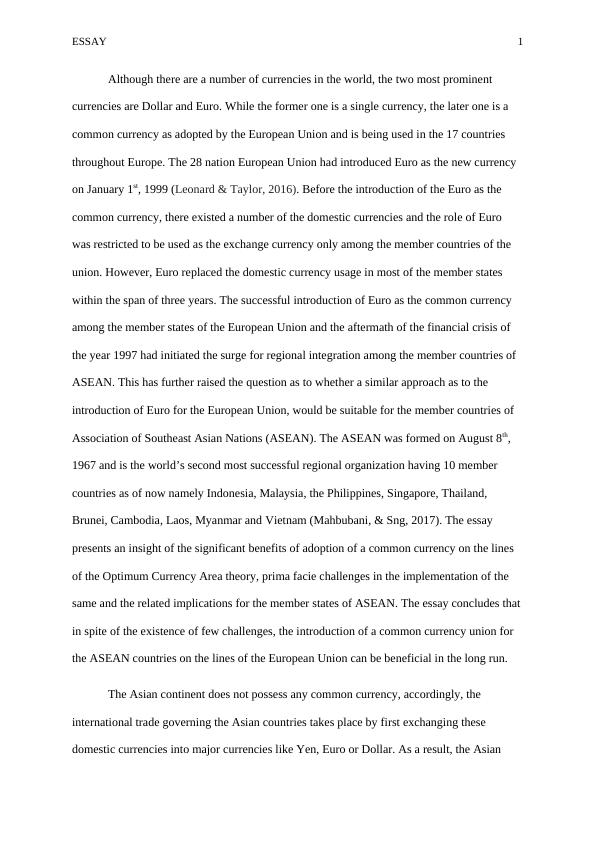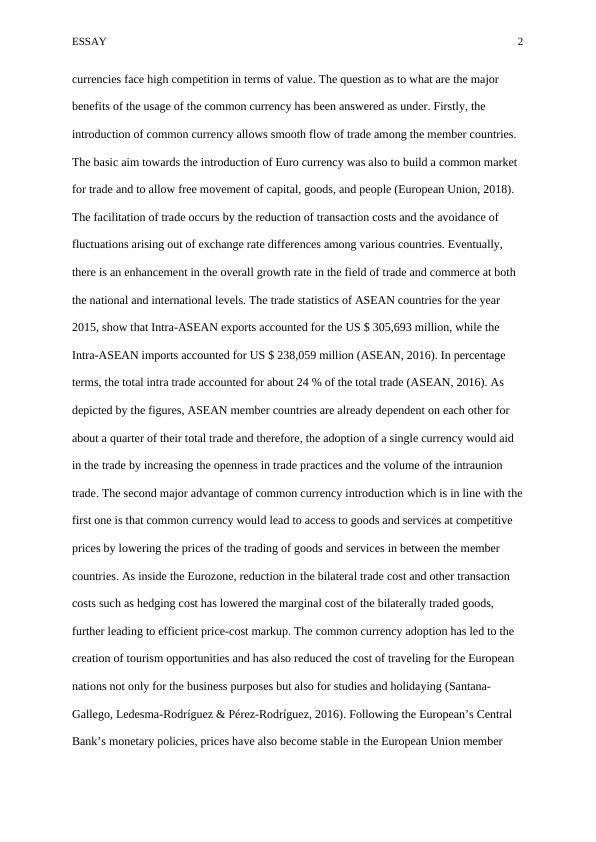Benefits and Challenges of Common Currency Adoption for ASEAN Countries
Added on 2023-06-11
9 Pages2760 Words80 Views
June 22nd, 2018

ESSAY 1
Although there are a number of currencies in the world, the two most prominent
currencies are Dollar and Euro. While the former one is a single currency, the later one is a
common currency as adopted by the European Union and is being used in the 17 countries
throughout Europe. The 28 nation European Union had introduced Euro as the new currency
on January 1st, 1999 (Leonard & Taylor, 2016). Before the introduction of the Euro as the
common currency, there existed a number of the domestic currencies and the role of Euro
was restricted to be used as the exchange currency only among the member countries of the
union. However, Euro replaced the domestic currency usage in most of the member states
within the span of three years. The successful introduction of Euro as the common currency
among the member states of the European Union and the aftermath of the financial crisis of
the year 1997 had initiated the surge for regional integration among the member countries of
ASEAN. This has further raised the question as to whether a similar approach as to the
introduction of Euro for the European Union, would be suitable for the member countries of
Association of Southeast Asian Nations (ASEAN). The ASEAN was formed on August 8th,
1967 and is the world’s second most successful regional organization having 10 member
countries as of now namely Indonesia, Malaysia, the Philippines, Singapore, Thailand,
Brunei, Cambodia, Laos, Myanmar and Vietnam (Mahbubani, & Sng, 2017). The essay
presents an insight of the significant benefits of adoption of a common currency on the lines
of the Optimum Currency Area theory, prima facie challenges in the implementation of the
same and the related implications for the member states of ASEAN. The essay concludes that
in spite of the existence of few challenges, the introduction of a common currency union for
the ASEAN countries on the lines of the European Union can be beneficial in the long run.
The Asian continent does not possess any common currency, accordingly, the
international trade governing the Asian countries takes place by first exchanging these
domestic currencies into major currencies like Yen, Euro or Dollar. As a result, the Asian
Although there are a number of currencies in the world, the two most prominent
currencies are Dollar and Euro. While the former one is a single currency, the later one is a
common currency as adopted by the European Union and is being used in the 17 countries
throughout Europe. The 28 nation European Union had introduced Euro as the new currency
on January 1st, 1999 (Leonard & Taylor, 2016). Before the introduction of the Euro as the
common currency, there existed a number of the domestic currencies and the role of Euro
was restricted to be used as the exchange currency only among the member countries of the
union. However, Euro replaced the domestic currency usage in most of the member states
within the span of three years. The successful introduction of Euro as the common currency
among the member states of the European Union and the aftermath of the financial crisis of
the year 1997 had initiated the surge for regional integration among the member countries of
ASEAN. This has further raised the question as to whether a similar approach as to the
introduction of Euro for the European Union, would be suitable for the member countries of
Association of Southeast Asian Nations (ASEAN). The ASEAN was formed on August 8th,
1967 and is the world’s second most successful regional organization having 10 member
countries as of now namely Indonesia, Malaysia, the Philippines, Singapore, Thailand,
Brunei, Cambodia, Laos, Myanmar and Vietnam (Mahbubani, & Sng, 2017). The essay
presents an insight of the significant benefits of adoption of a common currency on the lines
of the Optimum Currency Area theory, prima facie challenges in the implementation of the
same and the related implications for the member states of ASEAN. The essay concludes that
in spite of the existence of few challenges, the introduction of a common currency union for
the ASEAN countries on the lines of the European Union can be beneficial in the long run.
The Asian continent does not possess any common currency, accordingly, the
international trade governing the Asian countries takes place by first exchanging these
domestic currencies into major currencies like Yen, Euro or Dollar. As a result, the Asian

ESSAY 2
currencies face high competition in terms of value. The question as to what are the major
benefits of the usage of the common currency has been answered as under. Firstly, the
introduction of common currency allows smooth flow of trade among the member countries.
The basic aim towards the introduction of Euro currency was also to build a common market
for trade and to allow free movement of capital, goods, and people (European Union, 2018).
The facilitation of trade occurs by the reduction of transaction costs and the avoidance of
fluctuations arising out of exchange rate differences among various countries. Eventually,
there is an enhancement in the overall growth rate in the field of trade and commerce at both
the national and international levels. The trade statistics of ASEAN countries for the year
2015, show that Intra-ASEAN exports accounted for the US $ 305,693 million, while the
Intra-ASEAN imports accounted for US $ 238,059 million (ASEAN, 2016). In percentage
terms, the total intra trade accounted for about 24 % of the total trade (ASEAN, 2016). As
depicted by the figures, ASEAN member countries are already dependent on each other for
about a quarter of their total trade and therefore, the adoption of a single currency would aid
in the trade by increasing the openness in trade practices and the volume of the intraunion
trade. The second major advantage of common currency introduction which is in line with the
first one is that common currency would lead to access to goods and services at competitive
prices by lowering the prices of the trading of goods and services in between the member
countries. As inside the Eurozone, reduction in the bilateral trade cost and other transaction
costs such as hedging cost has lowered the marginal cost of the bilaterally traded goods,
further leading to efficient price-cost markup. The common currency adoption has led to the
creation of tourism opportunities and has also reduced the cost of traveling for the European
nations not only for the business purposes but also for studies and holidaying (Santana-
Gallego, Ledesma-Rodríguez & Pérez-Rodríguez, 2016). Following the European’s Central
Bank’s monetary policies, prices have also become stable in the European Union member
currencies face high competition in terms of value. The question as to what are the major
benefits of the usage of the common currency has been answered as under. Firstly, the
introduction of common currency allows smooth flow of trade among the member countries.
The basic aim towards the introduction of Euro currency was also to build a common market
for trade and to allow free movement of capital, goods, and people (European Union, 2018).
The facilitation of trade occurs by the reduction of transaction costs and the avoidance of
fluctuations arising out of exchange rate differences among various countries. Eventually,
there is an enhancement in the overall growth rate in the field of trade and commerce at both
the national and international levels. The trade statistics of ASEAN countries for the year
2015, show that Intra-ASEAN exports accounted for the US $ 305,693 million, while the
Intra-ASEAN imports accounted for US $ 238,059 million (ASEAN, 2016). In percentage
terms, the total intra trade accounted for about 24 % of the total trade (ASEAN, 2016). As
depicted by the figures, ASEAN member countries are already dependent on each other for
about a quarter of their total trade and therefore, the adoption of a single currency would aid
in the trade by increasing the openness in trade practices and the volume of the intraunion
trade. The second major advantage of common currency introduction which is in line with the
first one is that common currency would lead to access to goods and services at competitive
prices by lowering the prices of the trading of goods and services in between the member
countries. As inside the Eurozone, reduction in the bilateral trade cost and other transaction
costs such as hedging cost has lowered the marginal cost of the bilaterally traded goods,
further leading to efficient price-cost markup. The common currency adoption has led to the
creation of tourism opportunities and has also reduced the cost of traveling for the European
nations not only for the business purposes but also for studies and holidaying (Santana-
Gallego, Ledesma-Rodríguez & Pérez-Rodríguez, 2016). Following the European’s Central
Bank’s monetary policies, prices have also become stable in the European Union member

End of preview
Want to access all the pages? Upload your documents or become a member.
Related Documents
Multiple Or Single Currency System for ASEAN Reportlg...
|11
|3116
|177
Report on the International Financelg...
|9
|2465
|75
Should ASEAN countries adopt common currency?lg...
|10
|2761
|347
Report on Common Currency for ASEAN Countrieslg...
|15
|2554
|139
International Financial Markets Institutionslg...
|10
|2720
|63
Global Business: The European Economic Community, MNCs Internationalisation, and Market Entry Analysis of Tescolg...
|16
|5328
|85
